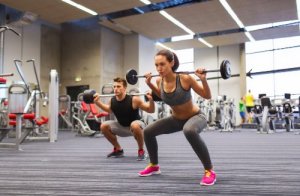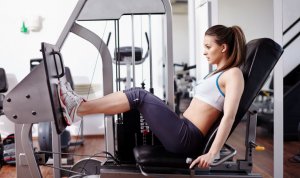Balanced Workout Tips: Recommendations for a Well-Rounded Routine

When we talk about a balanced workout, we could be referring to a number of aspects relating to an exercise routine. In general, it describes a measured approach to working each muscle group with the same intensity. However, it can also apply to other areas of our workout routine.
While the concept of a balanced workout is practically inseparable from the act of planning a routine, it is not always taken into account. Do you know someone who works out religiously but almost never focuses on their legs?
This kind of mistake is both common and dangerous. It can cause real damage to your body, throwing off balance its natural equilibrium and making it more injury-prone due to poor posture.
How to achieve a balanced workout
A first basic recommendation has to do with putting serious planning into your routine. If you go to a gym, your best bet is to leave your planning in the hands of your trainer. He or she will know what exercises will best suit your needs and goals.
The next step, obviously, is sticking to it. While it is understandable that there are exercises you would rather skip, it does not mean you should.
Avoiding certain areas will warp the results of your routine. For example, if you gain muscle mass (and weight) in your upper body, but your legs cannot support the weights that you use and your body weight, sooner or later you will end up suffering with an injury.
How much do I need to work each muscle group?
When it comes to physical training, no two people are exactly alike, which makes this a tough question to answer. There are also other factors to consider, such as your goals, what your activities are, what your lifestyle was like before working out, etc.

Nevertheless, you can establish certain general parameters to serve as a guide:
Strength exercises
These form the base of most gym routines, CrossFit workouts, and weightlifting routines. In this sense, we need to highlight the importance of spending time on all the muscle groups.
It becomes a bit complicated when you consider the amount of time you have to spend on each muscle group every week. This is not easy to determine, given that you have to factor in things such as, the intensity and the amount of training required, genetics, diet, and rest.
In any case, the general guidelines are as follows:
- Go back to a muscle group shortly after it has recovered from the last session. This may take a day or two (or more), depending on the intensity of the workout.
- You have to work every muscle group at least once a week. The amount of exercise you do varies depending on the days that you train.
- Usually, the larger muscle groups – chest, back, and legs – should be worked on different days, complemented by more specific groups like the triceps, biceps, and shoulders.
Aerobic work
Generally, aerobic work should wait until the end of your routine. This type of exercise elevates the intensity of your breathing. It also makes your body consume more energy. As a result, you will burn more fat. In addition, it contributes to the improvement of the cardiovascular system, and the body’s metabolism in general.
Trainers generally recommend doing between 20 and 40 minutes of aerobic activity after a strength-based workout. However, these times can vary, depending on a person’s specific needs.
Flexibility exercises
Although often ignored, flexibility exercises (or stretches) are almost as important as strength and aerobic workouts. They are usually left for the end of a workout, as they help the muscles to relax and return to their original state following the exertion of the routine.
After each session, you should do between 10 and 20 minutes of stretching. This will help you to avoid injury, improve mobility, and help your body recover more quickly.

Balancing sides
While many exercises involve using machines that distribute the weight equally – such as the press or the pulley – those done using bars or dumbbells allow you to choose the amount of weight you want.
Many people believe that it is best to work out each muscle to the max. As such, if the right arm is stronger than the left, it seems logical to work out the former with more weight. This is a serious mistake.
Weights should always be used in a balanced manner, regardless of whether one side can handle more than the other. The reason is simple: you should not risk creating an imbalance that will ruin your exercise posture. This can lead to serious injury.
The concept of a balanced workout also applies to antagonistic muscles such as, the biceps/triceps, and hamstrings/thighs. These should also be worked with the same intensity, in a way that does not hinder the natural function of the body.
When we talk about a balanced workout, we could be referring to a number of aspects relating to an exercise routine. In general, it describes a measured approach to working each muscle group with the same intensity. However, it can also apply to other areas of our workout routine.
While the concept of a balanced workout is practically inseparable from the act of planning a routine, it is not always taken into account. Do you know someone who works out religiously but almost never focuses on their legs?
This kind of mistake is both common and dangerous. It can cause real damage to your body, throwing off balance its natural equilibrium and making it more injury-prone due to poor posture.
How to achieve a balanced workout
A first basic recommendation has to do with putting serious planning into your routine. If you go to a gym, your best bet is to leave your planning in the hands of your trainer. He or she will know what exercises will best suit your needs and goals.
The next step, obviously, is sticking to it. While it is understandable that there are exercises you would rather skip, it does not mean you should.
Avoiding certain areas will warp the results of your routine. For example, if you gain muscle mass (and weight) in your upper body, but your legs cannot support the weights that you use and your body weight, sooner or later you will end up suffering with an injury.
How much do I need to work each muscle group?
When it comes to physical training, no two people are exactly alike, which makes this a tough question to answer. There are also other factors to consider, such as your goals, what your activities are, what your lifestyle was like before working out, etc.

Nevertheless, you can establish certain general parameters to serve as a guide:
Strength exercises
These form the base of most gym routines, CrossFit workouts, and weightlifting routines. In this sense, we need to highlight the importance of spending time on all the muscle groups.
It becomes a bit complicated when you consider the amount of time you have to spend on each muscle group every week. This is not easy to determine, given that you have to factor in things such as, the intensity and the amount of training required, genetics, diet, and rest.
In any case, the general guidelines are as follows:
- Go back to a muscle group shortly after it has recovered from the last session. This may take a day or two (or more), depending on the intensity of the workout.
- You have to work every muscle group at least once a week. The amount of exercise you do varies depending on the days that you train.
- Usually, the larger muscle groups – chest, back, and legs – should be worked on different days, complemented by more specific groups like the triceps, biceps, and shoulders.
Aerobic work
Generally, aerobic work should wait until the end of your routine. This type of exercise elevates the intensity of your breathing. It also makes your body consume more energy. As a result, you will burn more fat. In addition, it contributes to the improvement of the cardiovascular system, and the body’s metabolism in general.
Trainers generally recommend doing between 20 and 40 minutes of aerobic activity after a strength-based workout. However, these times can vary, depending on a person’s specific needs.
Flexibility exercises
Although often ignored, flexibility exercises (or stretches) are almost as important as strength and aerobic workouts. They are usually left for the end of a workout, as they help the muscles to relax and return to their original state following the exertion of the routine.
After each session, you should do between 10 and 20 minutes of stretching. This will help you to avoid injury, improve mobility, and help your body recover more quickly.

Balancing sides
While many exercises involve using machines that distribute the weight equally – such as the press or the pulley – those done using bars or dumbbells allow you to choose the amount of weight you want.
Many people believe that it is best to work out each muscle to the max. As such, if the right arm is stronger than the left, it seems logical to work out the former with more weight. This is a serious mistake.
Weights should always be used in a balanced manner, regardless of whether one side can handle more than the other. The reason is simple: you should not risk creating an imbalance that will ruin your exercise posture. This can lead to serious injury.
The concept of a balanced workout also applies to antagonistic muscles such as, the biceps/triceps, and hamstrings/thighs. These should also be worked with the same intensity, in a way that does not hinder the natural function of the body.
This text is provided for informational purposes only and does not replace consultation with a professional. If in doubt, consult your specialist.








